Journal of Modern Physics
Vol. 2 No. 8 (2011) , Article ID: 6715 , 8 pages DOI:10.4236/jmp.2011.28101
Formulae for Energy and Momentum of Relativistic Particle Regular at Zero-Mass State
1Joint Institute for Nuclear Research, LIT, Dubna, Russia
2Departamento de Fsica, Facultad de Estudios Superiores, Universidad Nacional Autonoma de Mexico Cuautitlán Izcalli, Campo 1, México
E-mail: iamaleev@servidor.unam.mx
Received October 22, 2010; revised March 2, 2011; accepted April 13, 2011
Keywords: Relativistic Dynamics, Complex Algebra, Rapidity, Energy-Momentum, Background Energy, Statistical Thermodynamics
ABSTRACT
In this paper we substantiate a necessity of introduction of a concept the counterpart of rapidity into the framework of relativistic physics. It is shown, formulae for energy and momentum defined via counterpart of rapidity are regular near the zero-mass and speed of light states. The representation for the energy-momentum is realized as a mapping from the massless-state onto the massive one which looks like as a “q”-deformation. Quantization of the energy, momentum and the velocity near the light-speed is presaged. An analogue between the relativistic dynamics and the statistical thermodynamics of a micro-canonical ensemble is brought to light.
1. Introduction
The developments of the basic theories in the fields of solid state and elementary particles exhibit a crucial importance of the behavior of the physical systems near the critical points. The experimental results and their theoretical treatments have discovered the new physical phenomena named as spontaneously broken symmetries near the ground state. That a ground state of a quantal system need not possess the Hamiltonian’s symmetries, and therefore degenerate, was first appreciated and realized in non-relativistic many body systems and in many condensed matter situations. Also that had been realized, the state of superconductivity possesses with lower entropy (hence, with higher order) then a normal state. Following this understanding Heisenberg [1] and Nambu [2] made the seminal suggestion that this may also be true for the vacuum state of a relativistic quantum field theory.
For the relativistic mechanics the state with 
 , i.e., the state with proper mass equal to zero and the velocity equal to speed of light, is a singular point of the theory. The massive particles, according to laws of the relativistic mechanics, cannot attain the velocity equal to speed of light. The formulae of the Lorentz transformations and formulae for the energy-momentum of the relativistic massive particle are singular near the velocity equal to speed of light, whereas they are well defined for the rest state. In general, it is supposed that near the speed of light the dynamics of a massive elementary particle more does not obey the classical mechanics of a single particle and one must work in the scope of the quantum field theory. In fact, acceleration of the charged particle induces radiation of electromagnetic fields and leads to cumulative process of creation of a cascade of elementary particles. Noteworthy a crucial gap between massive and massless states: the particle with extremely small value of mass can stay in the rest state, meanwhile its neighbour, the particle with
, i.e., the state with proper mass equal to zero and the velocity equal to speed of light, is a singular point of the theory. The massive particles, according to laws of the relativistic mechanics, cannot attain the velocity equal to speed of light. The formulae of the Lorentz transformations and formulae for the energy-momentum of the relativistic massive particle are singular near the velocity equal to speed of light, whereas they are well defined for the rest state. In general, it is supposed that near the speed of light the dynamics of a massive elementary particle more does not obey the classical mechanics of a single particle and one must work in the scope of the quantum field theory. In fact, acceleration of the charged particle induces radiation of electromagnetic fields and leads to cumulative process of creation of a cascade of elementary particles. Noteworthy a crucial gap between massive and massless states: the particle with extremely small value of mass can stay in the rest state, meanwhile its neighbour, the particle with , has to move with the speed of light.
, has to move with the speed of light.
The irregular behavior of the conventional representations for energy-momentum near the zero-mass point is a well-known problem of the relativistic mechanics. In fact, the celebrated formulae for the energy-momentum  defined via velocity
defined via velocity ,
,
 (1.1)
(1.1)
could not be used to obtain any reasonable limit at the points ,
,  , because the indeterminacy of type
, because the indeterminacy of type
 , meanwhile, the energy and momentum of the particle with
, meanwhile, the energy and momentum of the particle with  are given by a certain finite value. In fact, in order to prove this assertion we may use the expression of the energy via momentum
are given by a certain finite value. In fact, in order to prove this assertion we may use the expression of the energy via momentum
 (1.2)
(1.2)
For small values of the mass,  , we can use the following approximation
, we can use the following approximation
 (1.3)
(1.3)
Hence, when ,
,  the velocity tends to speed of light,
the velocity tends to speed of light, . The energy and momentum at this limit numerically are equal to each other and equal some finite value.
. The energy and momentum at this limit numerically are equal to each other and equal some finite value.
The following question gives arise: what kind of the law of relativistic dynamics can help us to solve this indeterminacy? Or, in the other words, how we must modify, or generalize, the conventional frames of the theory in order to elaborate some pathway from the state with non-vanishing proper mass to the state with zero-mass?
In order to answer these questions we have to deepen the concept of rapidity. The rapidity is well-known quantity of the relativistic kinematics, this is an hyperbolic angle used as a parameter of the Lorentz-boost in the Lorentz group of transformations. Most physicists maintained that the rapidity is a merely formal quantity because the rapidity did not receive any physical interpretation in the framework of the relativistic kinematics [3]. Nevertheless, it had been noted that the rapidity plays an important role in establishing some link between the hyperbolic geometry and relativistic kinematics. This link firstly had been discovered by V. Varicak [4], H. Hergoltz [5] and A. A. Rob [6]. Contemporary model of relativistic kinematics based on non-associative algebras and on the concept of gruppoids had been constructed by A. Ungar [7].
According to our point of view, the rapidity is one of principal notions of the relativistic dynamics. An essential role plays a quantity dual to the rapidity, we denominate as the counterpart of rapidity. Introduction of the counterpart of rapidity is related with discovery of a new features of dynamical variables of the relativistic mechanics. The counterpart of rapidity is a rapidity related with the systems of references coming from the light-speed state toward to the rest state. Therefore the expressions for energy, momentum and velocity expressed via the counterpart of rapidity are regular at the state with . The new representation for energy and momentum can be considered as a mapping from the massless state onto the state with mass.
. The new representation for energy and momentum can be considered as a mapping from the massless state onto the state with mass.
An important feature of the counterpart of rapidity is that the hyperbolic angle is proportional to the proper mass of a particle. The part of the hyperbolic angle independent of the mass can be interpreted via the concept of background energy. The relativistic energy-momentum within the framework of the new representation formally coincides with formulae of statistical thermodynamics of an single oscillator which allows one to give an interpretation of the background energy by introducing the quantities of the state like temperature and entropy.
The paper besides of the Introduction and Conclusions is presented by the following sections.
Section 2 presents elements of the relativistic dynamics of charged particle. In Section 3, an evolution generated by mass-shell equation is explored. Transmission between translation and hyperbolic rotation is established. In Section 4, the representation for the momenta is modified by introducing a fundamental constant of mass. The modified formula is interpreted as a mapping from massless state onto the state with nontrivial mass. A hypothesis on quantization of the velocity near light velocity is suggested. In Section 5, an analogue between formulae of relativistic mechanics and formulae of statistical thermodynamics is demonstrated.
2. Elements of Relativistic Dynamics of Charged Particle
In this section we will remind only selected elements of the relativistic dynamics of charged particle necessary in subsequent sections.
Consider a motion of the relativistic particle with charge  in the external electromagnetic fields
in the external electromagnetic fields  and
and . The relativistic equations of motion with respect to the proper time
. The relativistic equations of motion with respect to the proper time  are given by the Lorentz-force equations [8]:
are given by the Lorentz-force equations [8]:
 (2.1)
(2.1)
 (2.2)
(2.2)
These equations imply the first integral of motion
 (2.3)
(2.3)
The constant of motion has obtained its interpretation as a square of proper mass of the relativistic particle, so that, . In the case of stationary potential field, i.e. when
. In the case of stationary potential field, i.e. when  the equations imply the other constant of motion, the energy of the relativistic particle
the equations imply the other constant of motion, the energy of the relativistic particle
 (2.4)
(2.4)
In order to give a main idea we shall restrict ourselves by considering only lengths of the momenta. For that purpose let us consider the projection of Equation (2.1) onto direction of motion. In this way we come to the following set of equations
 (2.5)
(2.5)
where
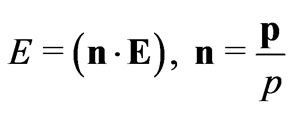 (2.6)
(2.6)
Equation (2.5) can be integrated with respect to parameter . We find
. We find
 (2.7)
(2.7)
Let  for the rest state where
for the rest state where . Then (2.7) is redefined as follows
. Then (2.7) is redefined as follows
 (2.8)
(2.8)
Velocity with respect to coordinate time is defined by
 (2.9)
(2.9)
Comparing this formula with the formulae used in the relativistic kinematics we come to conclusion that the parameter coincides with hyperbolic angle denominated in Lorentz-kinematics as the rapidity. In Equation (2.5) the rapidity
coincides with hyperbolic angle denominated in Lorentz-kinematics as the rapidity. In Equation (2.5) the rapidity  is presented as a complementary dynamical variable.
is presented as a complementary dynamical variable.
The evolution governed by Lorentz-force Equation (2.1) changes the quantities  in a such way that remain invariant the mass-shell Equation (2.3). The rapidity during of this evolution undergoes to translations.
in a such way that remain invariant the mass-shell Equation (2.3). The rapidity during of this evolution undergoes to translations.
Notice, however this is not unique form of variation of  remaining invariant the mass-shell Equation (2.3). Now let us explore another form of evolutions of the energy-momentum which also remain invariant the massshell equation.
remaining invariant the mass-shell Equation (2.3). Now let us explore another form of evolutions of the energy-momentum which also remain invariant the massshell equation.
Following references [9,10], let us introduce two quantities  by
by
 (2.10)
(2.10)
Inversely,
 (2.11)
(2.11)
The quantities  form the set of eigenvalues of the quadratic polynomial
form the set of eigenvalues of the quadratic polynomial
 (2.12)
(2.12)
with respect to which relationships (2.10) play the role of Vieta’s formulae. Under translation  the quadratic polynomial takes the form of mass-shell equation:
the quadratic polynomial takes the form of mass-shell equation:

Observation 2.1
The mass-shell equation remains invariant under additive changes (simultaneous translations) of the pair of quantities ,
,
 (2.13)
(2.13)
These translations result an additive change of the kinetic part of the energy
 (2.14)
(2.14)
In the same spirit as a solution of the quadratic equation , the imaginary
, the imaginary , generates algebra of complex numbers, the solution of quadratic Equation (2.12) generates an algebra of general complex numbers [12,13]. In references [14,15], some geometrical and algebraical properties of the evolution governed by by quadratic Equation (2.12) had been explored. Since
, generates algebra of complex numbers, the solution of quadratic Equation (2.12) generates an algebra of general complex numbers [12,13]. In references [14,15], some geometrical and algebraical properties of the evolution governed by by quadratic Equation (2.12) had been explored. Since  are roots of the quadratic Equation (2.10), the following Euler formulae hold true
are roots of the quadratic Equation (2.10), the following Euler formulae hold true
 (2.15)
(2.15)
Form the following ratio
 (2.16)
(2.16)
where
 (2.17)
(2.17)
Translations  remain invariant
remain invariant , hence
, hence
 (2.18)
(2.18)
Let, . Then,
. Then,
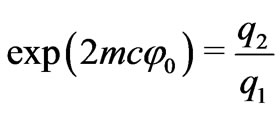 (2.19)
(2.19)
The formula (2.19) is a Key-formula of the hyperbolic calculus. This formula establishes some interrelation between simultaneous translations of denominator and numerator of the fraction and the hyperbolic rotation.
3. Counterpart of Rapidity and Representations for Energy-Momentum Regular Near Zero-Mass State
From Key-formula (2.19) by taking into account (2.11) we get
 (3.16)
(3.16)
Any set of momenta  with
with  real positive finite numbers may serve as a generator of the evolution where the initial point is defined by
real positive finite numbers may serve as a generator of the evolution where the initial point is defined by
 (3.17)
(3.17)
and
 (3.18)
(3.18)
From these equations the following useful relationship is derived
 (3.19)
(3.19)
With respect to  the evolution of energymomentum is given by following equations:
the evolution of energymomentum is given by following equations:
 (3.20)
(3.20)
The evolution of kinetic energy is described by nonlinear equation
 (3.21)
(3.21)
Thus, we possess now with two different representations for the energy and momentum via hyperbolic trigonometry.
One is a function of the rapidity  given by
given by
 (3.22)
(3.22)
And the other one describes an evolution with respect to counterpart of rapidity :
:
 (3.23)
(3.23)
The former is regular at the rest state, these formulae we shall denominated as the low-speed representation. The latter is regular at the state of speed of light, these formulae, correspondingly, we shall named as highspeed representation.
From the low-speed representation we come to the formula for energy near the rest state for slow motion, this is, so-called, non-relativistic limit.
In order to obtain the non-relativistic limit we use expansion of (3.22) for small values of :
:

Removing from these equations , we get
, we get
 (3.24)
(3.24)
or,
 (3.25)
(3.25)
where  is expression for kinetic energy of Newtonian mechanics.
is expression for kinetic energy of Newtonian mechanics.
The high-speed representation allows to obtain analogous expression for energy near the light-speed state. For small values of  we come to the following expansion
we come to the following expansion

Removing from these equations , we get
, we get
 (3.26)
(3.26)
From comparison of formulae (3.25) and (3.26) we conclude that the mass and momentum at these limits are mutually replaced. Formulae (3.23) near the light-speed state are given by

It is seen, at the limit  we have
we have
 (3.27)
(3.27)
Here we introduced the new quantity  which is equal to energy-momentum of the relativistic system at the state
which is equal to energy-momentum of the relativistic system at the state . In the rest state the energy is equal to the proper inertial mass (in energy units) and, in the same manner, in the state of the light-speed the energy is equal to
. In the rest state the energy is equal to the proper inertial mass (in energy units) and, in the same manner, in the state of the light-speed the energy is equal to . Thus, the relativistic dynamics of the relativistic particle beside the inertial mass
. Thus, the relativistic dynamics of the relativistic particle beside the inertial mass  contains a parameter dual to the proper mass (we suggest to denominate this value as light-mass). The parameter
contains a parameter dual to the proper mass (we suggest to denominate this value as light-mass). The parameter  determines the value of the kinetic energy of the motion. This quantity corresponds to the energy of the particle in its massless state.
determines the value of the kinetic energy of the motion. This quantity corresponds to the energy of the particle in its massless state.
Now let us underline some reciprocity between two hyperbolic angles  and
and . For that purpose introduce complementary to
. For that purpose introduce complementary to  velocity
velocity  obeying the following equation
obeying the following equation
 (3.28)
(3.28)
Notice that  is related with hyperbolic parameter (
is related with hyperbolic parameter ( ) in a manner quite similar as
) in a manner quite similar as  is expressed via rapidity
is expressed via rapidity :
:
 (3.29)
(3.29)
Interrelation between  and
and  is expressed by the following formulae of reciprocity
is expressed by the following formulae of reciprocity
 (3.30)
(3.30)
From these formulae it follows that  and
and  when
when , and
, and  and
and  when
when . In some sense the pairs
. In some sense the pairs  and
and  are reciprocal to each other.
are reciprocal to each other.
4. q-Deformation and Quantization of the Energy-Momentum
Let us introduce some parameter in unit of mass and label this parameter by . Define a dimensionless variable
. Define a dimensionless variable  by
by
 (4.1)
(4.1)
Re-write formulae for the energy-momentum (3.18) in these variables
 (4.2)
(4.2)
Here we should notice that the formula for the momentum admits the following integral representation
 (4.3)
(4.3)
In [16] it has been shown that  geometrically can be interpreted as a curvature of a hyperbolic space. In this space the length of the circle with radius
geometrically can be interpreted as a curvature of a hyperbolic space. In this space the length of the circle with radius  is defined by formulae [17]:
is defined by formulae [17]:
 (4.4a)
(4.4a)
Correspondingly, the length of the circle with radius  is equal
is equal
 (4.4b)
(4.4b)
Taking into account this correspondence let us perform the following modifications in the formulae for energy-momentum
 (4.5)
(4.5)
 (4.6)
(4.6)
Noteworthy, the constant  now is not an arbitrary constant, but it has to be understood as a fundamental constant of the theory. Let us remember the formula of q-deformation of a quantity
now is not an arbitrary constant, but it has to be understood as a fundamental constant of the theory. Let us remember the formula of q-deformation of a quantity :
:
 (4.7)
(4.7)
From this point of view the last expression in (4.5) is q-deformation of  with parameter of deformation
with parameter of deformation . In notations of (4.7), Equation (4.5) can be written as follows
. In notations of (4.7), Equation (4.5) can be written as follows
 (4.8)
(4.8)
Notice,  for any
for any . There fore
. There fore

On the other hand, if  and
and  then from (4.8) it follows
then from (4.8) it follows
 (4.9)
(4.9)
Hence at the point  momentum of the particle with mass
momentum of the particle with mass  is equal to the momentum of the massless particle
is equal to the momentum of the massless particle
 (4.10)
(4.10)
Notice, however, the velocity of the particle at this point is not equal to the light velocity. In fact, these formulae imply existence of a point on the axis of momenta where the momenta of the massive and massless particles are equal. At this point the energy and the velocity are given by
 (4.11)
(4.11)
Now remember on integral representation (4.3). Now this fraction was replaced by
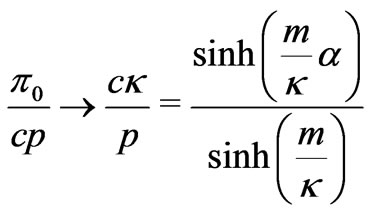 (4.12)
(4.12)
It is interesting to observe that for the new fraction (4.12) we shall obtain a sum instead of an integral if we assume that  is an integral number. Let
is an integral number. Let  be a halfinteger number with
be a halfinteger number with , and
, and . Then the following equation holds true.
. Then the following equation holds true.

This formula prompts us to introduce a hypothesis on quantization of . Experimentally the quantization can be observed near the light velocity where the velocity of the massive particle brings nearer the light velocity spasmodically according to law
. Experimentally the quantization can be observed near the light velocity where the velocity of the massive particle brings nearer the light velocity spasmodically according to law
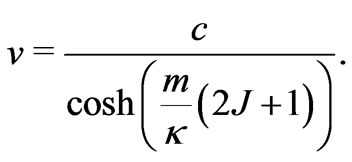
5. Analogue with Statistical Thermodynamics
In this section we are going to observe an interesting analogy between the formulae obtained in the previous sections for the energy-momentum and the well-known formulae of the statistical thermodynamics. This analogue exhibits a correspondence between the present representation of energy-momentum and the average energy of the single quantum mechanical oscillator. In this way we will come to the interpretation of  as an absolute temperature of a heat reservoir.
as an absolute temperature of a heat reservoir.
Let us start from formula for the momentum of the form
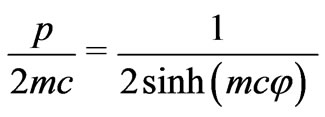 (5.1)
(5.1)
Notice that this expression can be represented as a sum of geometrical series. In fact,
 (5.2)
(5.2)
here the expression
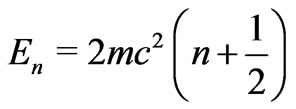
can be considered as a spectrum of the quantum oscillator where the role of zero point energy  is taken over by the energy at the rest
is taken over by the energy at the rest  of the particle. Furthermore, it is puzzled that the formula for the length of momentum per unit of mass is quite similar to the formula for single-particle partition function
of the particle. Furthermore, it is puzzled that the formula for the length of momentum per unit of mass is quite similar to the formula for single-particle partition function . The partition function for the single oscillator is [18]:
. The partition function for the single oscillator is [18]:
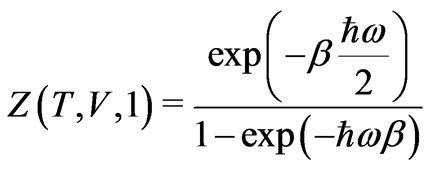 (5.3)
(5.3)
where

with absolute temperature  given in energy unit. Continuing the observation let us notice that the expression for the energy
given in energy unit. Continuing the observation let us notice that the expression for the energy  of the form
of the form
 (5.4)
(5.4)
is quite similar the expression for the mean energy of the single oscillator
 (5.5)
(5.5)
These observations lead us to the following correspondence between dynamic variables of the relativistic mechanics and the statistical thermo-dynamics:
 (5.6)
(5.6)
In reference [15] we have justified the following relationship between energy and momentum
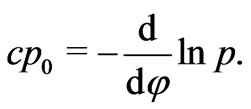 (5.7)
(5.7)
This equation quite analogous to the well-known equation of thermodynamics connecting internal energy  with the partition function
with the partition function :
:
 (5.8)
(5.8)
The evolution with respect to  now obtains its interpretation via statistical thermodynamics. In (5.4)(5.5) the terms
now obtains its interpretation via statistical thermodynamics. In (5.4)(5.5) the terms , as well as quantity
, as well as quantity , are exactly the contribution of the zero-point energy to the total energy. Furthermore, now we are able to introduce the notions of the free energy and the entropy. The free energy is
, are exactly the contribution of the zero-point energy to the total energy. Furthermore, now we are able to introduce the notions of the free energy and the entropy. The free energy is
 (5.9)
(5.9)
The entropy is (in unit ,
,  -constant of Boltzmann)
-constant of Boltzmann)
 (5.10)
(5.10)
Consider  distinguishable oscillators [19]. It is very instructive to calculate from the partition function
distinguishable oscillators [19]. It is very instructive to calculate from the partition function
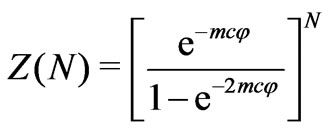 (5.11)
(5.11)
the corresponding density of states of the  -oscillator system. With the aid of the binomial expansion
-oscillator system. With the aid of the binomial expansion

we write

Comparing this with the general formula for  with discrete enumerable energies
with discrete enumerable energies

we find
 (5.12)
(5.12)
The energies  are just the zero-point energies of the
are just the zero-point energies of the  oscillators plus
oscillators plus  quanta of energy
quanta of energy . There are exactly
. There are exactly  ways to distribute these indistinguishable energy quanta among the
ways to distribute these indistinguishable energy quanta among the  distinguishable oscillators. The distribution of indistinguishable quanta instead of enumerated particles is the starting point of quantum statistics. Consider a collection of
distinguishable oscillators. The distribution of indistinguishable quanta instead of enumerated particles is the starting point of quantum statistics. Consider a collection of  identical quantum oscillators, supposed their distinguishable. The total number of distinguishable states
identical quantum oscillators, supposed their distinguishable. The total number of distinguishable states , corresponding to the energy
, corresponding to the energy , and all the probabilities turn out to be equal, as expected. It is simply
, and all the probabilities turn out to be equal, as expected. It is simply . Thus we can check whether the entropy
. Thus we can check whether the entropy  coincides with expression (5.10). Using
coincides with expression (5.10). Using  and Stirling's formula we get
and Stirling's formula we get

To obtain  the
the  must be inserted:
must be inserted:
 (5.13)
(5.13)
If we want to compare this with Equation (5.10), we must express the energy in terms of the “temperature”,
 (5.15)
(5.15)
which is identical to Equation (5.4).
It is interesting to compare the limiting cases for statistical thermodynamics and for the relativistic mechanics. In the case of high temperatures

the classical limit is recovered, because the characteristic parameter  measures the ratio of the energy levels of the oscillator compared to the mean thermal energy
measures the ratio of the energy levels of the oscillator compared to the mean thermal energy  which is available. In the mechanics the limit
which is available. In the mechanics the limit  corresponds to the state of massless particle, or to the state of light. At the limit of low temperature
corresponds to the state of massless particle, or to the state of light. At the limit of low temperature , one has the largest deviations from the classical case, where
, one has the largest deviations from the classical case, where
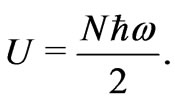
In the mechanics the limit  corresponds to the rest state
corresponds to the rest state  with the rest energy
with the rest energy .
.
6. Conclusions and Comments
In the present paper we gave a ground for new representation for energy, momentum and velocity via hyperbolic trigonometry the (hyperbolic) angle of which is proportional to the proper mass. The hyperbolic angle dual to the rapidity was denominated as counterpart of rapidity. We have worked primarily in the scopes of the dynamics, not kinematics, and restricted ourselves only with one dimensional case. It is well known that in the covariant formulation the rapidity is presented by antisymmetric tensor in four-dimensional Minkowski space. In that context the question gives arise: what kind tensorial object will present the counterpart of rapidity within the framework of covariant formulation? This question has a certain answer: in the covariant formulation the counterpart of rapidity is presented by the four-vector [20].
REFERENCES
- W. Heisenberg, “Zur Theorie de Elementarteilchen,” Zeit Naturforsch, Vol. 14a, 1959, pp. 441-451.
- Y. Nambu, “Dynamical Model of Elementary Particles Based on an Analogy with Superconductivity,” Physical Review, Vol. 117, 1960, pp. 648-659. doi:10.1103/PhysRev.117.648
- J.-M. Levy-Leblond, “A Gedankenexperiment in Science History,” American Journal of Physics, Vol. 48, 1980, pp. 345-354.
- V. Varicak, “Application of Lobachevskian Geometry in the Theory of Relativity,” Physikalische Zeitschrift, Vol. 11, 1910, pp. 93-96.
- H. Hergoltz, “Geometrical Aspects of Relativity Theory,” Ann.d.Phys, Vol.10, 1910, pp. 31-45.
- A. A. Robb, “Optical Geometry of Motion, a New View of the Theory of Relativity,” Cambridge, 1911.
- A. A. Ungar, “Hyperbolic Trigonometry and Its Applications in Poincaré Ball Model of Hyperbolic Geometry,” Computers & Mathematics with Applications, Vol. 41, No. 1-2, 2001, pp. 135-147. doi:10.1016/S0898-1221(01)85012-4
- A. O. Barut, “Electrodynamics and Classical Theory of Fields and Particles,” Dover Publications, Inc., New York, 1980.
- R. M. Yamaleev, “Extended Relativistic Dynamics of Charged Spinning Particle in Quaternionic Formulation,” Advances in Applied Clifford Algebras, Vol. 13, No. 2, 2003, pp. 183-218. doi:10.1007/s00006-003-0015-8
- R. M. Yamaleev, “Relativistic Equations of Motion within Nambu’s Formalism of Dynamics,” Annals of Physics, Vol. 285, No. 2, 2000, pp. 141-160. doi:10.1006/aphy.2000.6075
- A. R. Rodriguez-Dominguez, “Ecuaciones de fuerza de Lorentz Como Ecuaciones de Heisenberg,” Revista Mexicana de Fisica, Vol. 53, No. 4, 2007, pp. 270-280.
- I. M. Yaglom, “Complex Numbers in Geometry,” Academic Press, New York, 1968.
- P. Fjelstad and S. Gal, “Two Dimensional Geometries, Topologies, Trigonometries and Physics Generated by Complex-Type Numbers,” Advances in Applied Clifford Algebras, Vol. 11, No. 1, 2001, pp. 81-90. doi:10.1007/BF03042040
- R. M. Yamaleev, “Multicomplex Algebras on Polynomials and Generalized Hamilton Dynamics,” Journal of Mathematical Analysis and Applications, Vol. 322, No. 2, 2006, pp. 815-824. doi:10.1016/j.jmaa.2005.09.073
- R. M. Yamaleev, “Geometrical and Physical Interpretation of Evolution Governed by General Complex Algebra,” Journal of Mathematical Analysis and Application, Vol. 340, No. 2, 2008, pp. 1046-1057. doi:10.1016/j.jmaa.2007.09.018
- R. M. Yamaleev, “Complex Algebras on N-order Polynomials and Generalizations of Trigonometry, Oscillator Model and Hamilton Dynamics,” Advances in Applied Clifford Algebras, Vol. 15, No. 1, 2005, pp. 123-125.
- V. F. Kagan, “Gostexizdat,” Foundations of Geometry, Part I,” Moscow, 1949, pp. 331-336.
- W. Greiner, L. Neise and H. Stöcker, “Thermodynamics and Statistical Mechanics,” Springer-Verlag, New York, 1995, pp. 208-214, ISBN 0-387-94299-8.
- H. S. Robertson, “Statistical Thermodynamics,” PTR Prentice Hall, Englewood Cliffs, 1993, pp. 110-112, ISBN 0-13-845603-8.
- R. M. Yamaleev, “New Representation for EnergyMomentum and Its Applications to Relativistic Dynamics,” Nuclear Physics, Vol. 74, No. 7, 2011, pp. 1-8, (in Russian).

